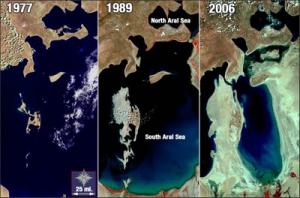Water securityClimate change rapidly warming world’s lakes, threatening freshwater supplies
Climate change is rapidly warming lakes around the world, threatening freshwater supplies and ecosystems, according to a study spanning six continents. The study is the largest of its kind and the first to use a combination of satellite temperature data and long-term ground measurements. A total of 235 lakes, representing more than half of the world’s freshwater supply, were monitored for at least twenty-five years. The study found that lakes are warming an average of 0.61 degrees Fahrenheit (0.34 degrees Celsius) each decade. This is greater than the warming rate of either the ocean or the atmosphere, and it can have profound effects, the scientists say.

Shrinking Aral Sea over a near 30-year period // Source: columbia.edu
Climate change is rapidly warming lakes around the world, threatening freshwater supplies and ecosystems, according to a study spanning six continents.
The study is the largest of its kind and the first to use a combination of satellite temperature data and long-term ground measurements. A total of 235 lakes, representing more than half of the world’s freshwater supply, were monitored for at least twenty-five years. The research, published in Geophysical Research Letters, was announced today at the American Geophysical Union meeting which is being held this week in San Francisco.
WSU reports that the study, which was funded by NASA and the National Science Foundation, found lakes are warming an average of 0.61 degrees Fahrenheit (0.34 degrees Celsius) each decade. This is greater than the warming rate of either the ocean or the atmosphere, and it can have profound effects, the scientists say.
Algal blooms, which can ultimately rob water of oxygen, are projected to increase 20 percent in lakes over the next century as warming rates increase. Algal blooms that are toxic to fish and animals would increase by 5 percent. If these rates continue, emissions of methane, a greenhouse gas twenty-five times more powerful than carbon dioxide on 100-year time scales, will increase 4 percent over the next decade.
“Society depends on surface water for the vast majority of human uses,” said co-author Stephanie Hampton, director of Washington State University’s Center for Environmental Research, Education and Outreach in Pullman. “Not just for drinking water, but manufacturing, for energy production, for irrigation of our crops. Protein from freshwater fish is especially important in the developing world.”
The temperature of water influences a host of its other properties critical to the health and viability of ecosystems. When temperature swings quickly and widely from the norm, life forms in a lake can change dramatically and even disappear.
“These results suggest that large changes in our lakes are not only unavoidable, but are probably already happening,” said lead author Catherine O’Reilly, associate professor of geology at Illinois State University, Normal. Earlier research by O’Reilly has seen declining productivity in lakes with rising temperatures.
